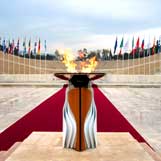Greece
![]()
History of the Olympics
The first Ancient Olympic Game was held in 776 BC, and it is considered to be the first recorded Greek historical event. Originally sprinting was the only competition, but in the 200 years that followed, boxing, discus, equestrian, javelin, long jump and wrestling were added. All contestants had to be Greek born and male. Depictions of all of the events are found in ancient Greek art, and are today common on souvenir plates, vases and urns that are typical fare in tourist shops and galleries.
In 490 BC, Greece was attacked by the Persians at the Bay of Marathon. The Greeks were certain to loose with only 10,000 hoplites (soldiers) compared to the 25,000 Persians. But the Greek commander, Miltiades, outsmarted the Persians with an enforced phalanx (mass army formation) and ultimately defeated them. When the battle was won, a Greek soldier was ordered to run to Athens in full battle gear to tell the city of this great victory. The soldier ran the 41 kilometers (26 miles) from Marathon to Athens, and after telling of the victory, he collapsed and died. From that year on the Marathon race was added to the Games.
In 146 BC the Romans took over control of the Games in Greece and from then on non-Greeks were allowed to enter the events. It was around this time that people were chosen to represent their city or region, instead of it being open events for anyone to join. Around 395 AD, with the fall of the Roman Empire, the Ancient Olympic Games were discontinued.
The first Modern Olympics were also held in Greece beginning on April 5, 1896. They were organized by a Frenchmen named Baron Pierre de Coubertin. The Kallimármaro (Panathinaikon) Stadium was built for these modern games thanks to a large donation from a wealthy Athenian. The stadium was built on the spot of previous stadiums, one dating from the 3rd Century BC and another from the 2nd Century AD. The stadium is a replica of Herodes Atticus's stadium built for the AD 144 Games. The stadium is made entirely of white Pentelic marble, is 669 feet long by 272 feet wide, and can seat 70,000 people. A large stadium by today's standards, let alone AD 144.
In 2004 the Olympics returned to Greece for the first time since 1896. Many events and ceremonies took place in the Kallimármaro Stadium (1896) and the marathon race still started in the town of Marathon and made its way to Athens. Two major differences between the Ancient Games and the Modern Games are that women now compete in almost every sport, and athletes wear high tech clothing instead of competing nude with heavily oiled bodies.

Europe travel news sent to you 15 times a year.
Top sights, hotel reviews, travel tips and more.
Private Tours in France, Greece, Italy and Spain.
Join one of our small group Europe tours.
Tours and day trips to help you explore Europe.
Hire a professional from Private Guides in Europe.
Let us help personalize your European itinerary.
Our thoughts on how to best travel in Europe.
For more information or to send us an email.
Car Rentals, Flights, Hotels, Rail Passes

